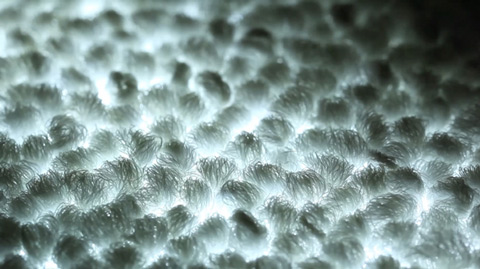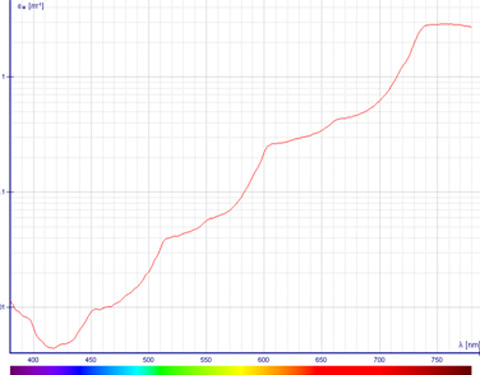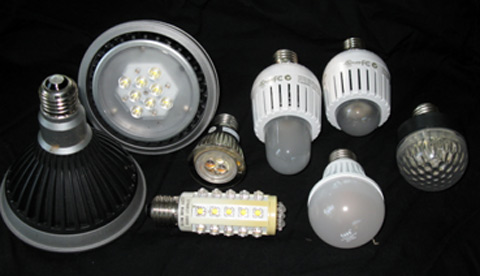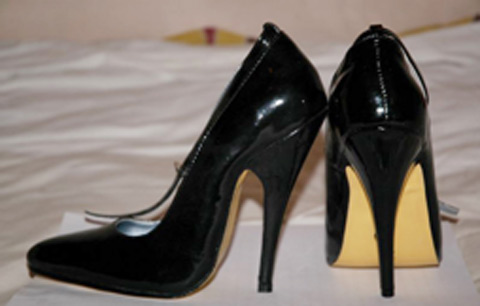Glowing Carpets: Rolling Out in 2014
February 3, 2014
Light transmissive carpets could save your life in an emergency, help you find your way in an airport, or simply give your room a unique glow! And you won’t have to wait long for luminous flooring; these carpets are rolling out later in 2014.

A close up of light transmitting carpet fibers being illuminated from below by LEDs.
Image credit: Philips and Desso.
Seriously, this is one smart floor. The carpet lighting can be switched on when a building alarm system goes off, illuminating a path when visibility’s low (like in a fire). While some exits may be blocked during a fire, this floor lighting system could direct you toward a safe exit while diverting you from fire blocked doors.
So why has it taken this long to create light-transmitting carpets? In fact, a lot of innovation and research was required to create transmissive carpets, and researchers continue to seek improvements. The research was and continues to be conducted by a familiar name in lighting, Philips, and in flooring, Desso.
Innovative Flooring
Objects interacting with light generally absorb, reflect, or transmit the light. Think of sunlight striking the surface of a large body of water: Some of it is reflected and some is transmitted into the water, allowing you to see under the surface. By the time you get a few meters down, the light has been absorbed by the water and transformed into infrared radiation that we cannot see.
Scientists often use the attenuation coefficient to describe how much light is absorbed by a medium (substance). The attenuation coefficient describes how far the light can travel before decreasing by a certain amount, and has units of inverse length.
If the attenuation coefficient is a large number, it means that the light gets absorbed very readily in the medium and does not travel too far through the medium. If the attenuation coefficient is extremely small, then the light can travel far without being absorbed and the material is basically transparent to that particular wavelength of light.
The graph below shows that in the visible light range, red light is far more readily absorbed by water than light between the violet and blue wavelengths.

Attenuation coeffiecient for visible light in liquid water.
Image credit: Darekk2 via Wikimedia Commons
Carpets, unlike large bodies of water, are not many meters thick, however the materials are far more opaque, meaning that light does not transmit through easily. Furthermore, the darker the color of fiber, the more absorption of light that occurs -- like wearing a black shirt on a sunny day, much of the visible light gets absorbed and re-radiated as the invisible infrared radiation that feels so warm.
For now, the light transmissive carpets are available in lighter colors that optimize the transmitted light. The lighter colored fibers also minimize absorption of particular colors of light being transmitted through.
For example, very white light shining through a beige carpet appears yellowish because the blue end of the spectrum is absorbed more than the green through red wavelengths. The color of the carpet and the colors of the light are important in the color we finally perceive as being transmitted through.
Carpets, and carpet tiles, are made with many layers. On the top layer lies a yarn of fibers, then a primary backing (a tuft substrate web). Underneath there’s a pre-coating layer in order to fix the pile yarn, followed by a heavy coating layer and finally a secondary backing.
Classic backing materials are black, grey, and brown and are nearly, if not totally, opaque. But Desso re-engineered every single layer: the yarn, the types of fibers used, the colors chosen, the pre-coating mixture, and even a new polyolefin polymer mixture used as a heavy coating.
They re-engineered all these layers to assure that the entire carpet tile transmits as much light as possible, or has the smallest attenuation coefficient for the wavelengths of light they want to transmit through.
The light transmitted through the carpets comes from below the bottom base layer of the carpet and is housed in a special floorboard. It’s important to keep the entire floor system as thin as possible, so only the minimum circuitry needed to get electricity to the lights and keep them cool is located in the floorboard.
Usually the semiconducting materials used to make a Light Emitting Diode (LED) are 1.5 mm thick. That was too thick, so Desso and Phillips re-engineered them to be 0.5 mm thick. The entire subfloor with all the LEDs in it is only 4 to 12 mm thick, depending on the type of lighting desired.
This required the engineers to place the remaining circuitry needed for the LEDs within the power box. The power box gets plugged in to the outlet in the wall or integrated with the circuitry involved with the alarm system of a building.
From the power box a slim 24-volt cable connects to the LED filled subfloor. About 20 watts of power are needed for the floor to display arrows and 100 watts for a one square meter video floor.
Watch the video to see a demonstration of what this smart floor can do!
LED’s (Light Emitting Diodes) are made from semiconducting devices, and the light they emit is directional unlike a regular incandescent or fluorescent bulb. Most LED bulbs that you can screw into a light socket are made of multiple LEDs.
The LED semiconducting chips utilize a direct current, so the alternating current from the wall outlet needs to be transformed, hence a power box for the carpet.
LEDs deteriorate with high temperatures, but they also emit a lot of thermal energy. In the image below the white or black material surrounding the under sides of the bulb is used to dissipate heat so the LED can be maintained at optimum temperatures.

LED light bulbs.
Image Credit: Geoffrey.landis via Wikimedia Commons.
For the smart carpets, Philips had to figure out a way to dissipate the heat so the bulbs can maintain their optimum temperature and not deteriorate. At the same time they had to keep the housing thin and strong enough to resist extreme forces. They sandwiched the LEDs between metal layers and special heat conducting materials. The layers also act as a “skin” that increases the strength of the housing.
The carpet, and lights, also needed to be water-resistant. To achieve this goal, engineers ensured that the carpet tile was impermeable to water, and the subfloor is covered with a water-resistant coating.
High Heel Physics
The system also has to withstand the impact of a person walking on it. Not just any person, but a person taking a step, with every bit of their weight impinging on the floor over an area of one stiletto heel.
The maximum energy transferred per area is given as 1500 newton meters per centimeter squared. This is equivalent to 7138 foot-pounds per square inch.

Image Credit: Xingbo via Wikimedia Commons
Consider the amount of pressure or force per unit area on the carpet. Imagine a person who weighs 55 kg (539 newtons), about 121 pounds. This is not considered the maximum sized person.
Now consider all of their weight being applied over an area of one circular heel, with a radius (half the width) of about 0.6 centimeters (0.24 inches). The area of the heel is the area of a circle, given by π*r2 = 1.13 square centimeters or 0.181 square inches. Then the force per area is given by 477 newtons/cm2 or 669 pounds per square inch.
That is a large force per area for not such a large person. Now consider a 90 kg (882 newtons) person, about 201 lbs, wearing the same shoes. The force per area goes up to 781 newtons/cm2 or 1110 lbs/in2. That is more than half a ton per square inch! The LEDs and fibers in this carpet have to withstand such forces.
Now...
LEDs can be made to emit red, green, and blue light. From mixing these three primary light colors in varying amounts, any color under the rainbow can be made. (Try out this simulation to make your own colors).
However, as mentioned before, the interaction of the light with the carpet alters the color observed. For now the colors of light used and the colors of carpet available are limited but research continues to be done to broaden the choices.
And Later
Philips and Desso continue to develop and broaden the carpeting and lighting systems. They want to share applications their applications and believe that it will have a much broader impact than enhancing emergency systems. The systems could be used to create decorative affects, functional applications such as general guidance where it is sometimes difficult to find your way.
References and Resources
1. Coffey, Valerie, LEDs Enable Futuristic Transmissive Carpet, Optics & Photonics News, November 2013http://www.osa-opn.org/home/newsroom/2013/november/leds_enable_futuristic_transmissive_carpet/#.UthgqXk6pfM
2. Philips website
http://www.newscenter.philips.com/main/standard/news/press/2013/20131118-Philips-and-Desso-announce-partnership-to-develop-light-transmissive-carpets.wpd#.UsY69yii6PE
3. Desso website
http://www.desso.com/news-events/news-overview/2013/11/philips-and-desso-announce-partnership-to-develop-light-transmissive-carpets/
—Heide Doss














